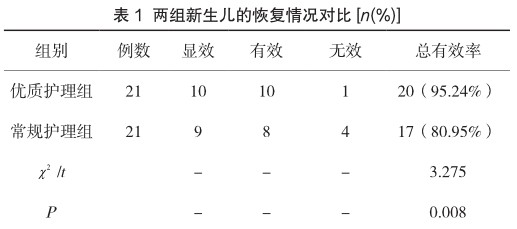护理干预对新生儿黄疸治疗效果及黄疸指数的影响


打开文本图片集
【摘 要】目的:讨论在新生儿黄疸的临床治疗中应用护理干预的价值和意义。方法:对42例出现黄疸的新生儿进行随机分配,得到了人数相等的常规护理组和优质护理组。不同组别的患儿应用对应的护理模式,评价两组患儿的临床恢复情况、治疗后的黄疸指数的动态变化、24h内的平均排便次数以及黄疸消退时间。结果:优质护理组的治疗有效率显著高于常规护理组,组间差异显著(P
【关键词】护理干预;常规护理;新生儿黄疸;临床疗效;黄疸指数
Effect of nursing intervention on neonatal jaundice treatment and jaundice index
QIN Mengjia
Liuzhou Liutie Central Hospital, Liuzhou, Guangxi 545000, China
【Abstract】Objective:To discuss the value and significance of nursing intervention in the clinical treatment of neonatal jaundice.Methods: 42 newborns with jaundice were randomly assigned, and the same number of routine nursing group and high-quality nursing group were obtained. Different groups of children applied the corresponding nursing model to evaluate the clinical recovery, the dynamic change of jaundice index after treatment, the average defecation times within 24 hours and the jaundice regression time of the two groups.Results: The effective rate of high-quality nursing group was significantly higher than that of routine nursing group(P
【Key?Words】Nursing intervention; Routine care; Jaundice of the newborn; Clinical efficacy; Jaundice index
为了讨论新生儿黄疸的临床治疗优化措施,本研究对比了优质护理干预和常规护理干预两种方式的护理效果,并且初步肯定了优质护理干预所具备的优势和价值[1]。(剩余3128字)